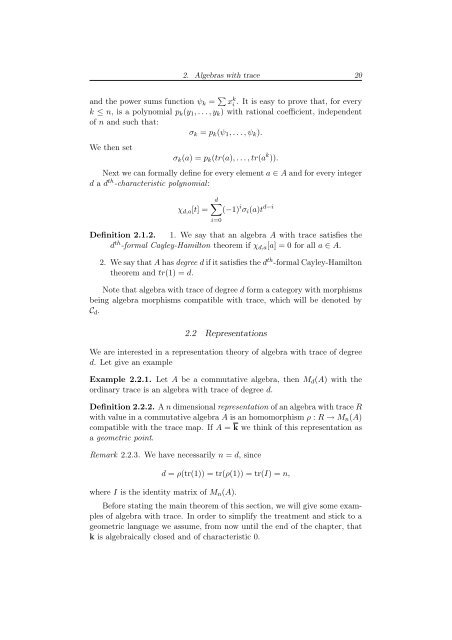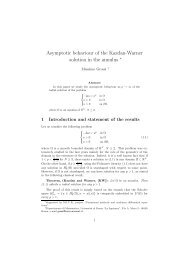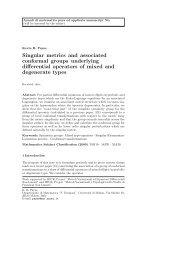Degree of Parabolic Quantum Groups - Dipartimento di Matematica ...
Degree of Parabolic Quantum Groups - Dipartimento di Matematica ...
Degree of Parabolic Quantum Groups - Dipartimento di Matematica ...
You also want an ePaper? Increase the reach of your titles
YUMPU automatically turns print PDFs into web optimized ePapers that Google loves.
2. Algebras with trace 20<br />
and the power sums function ψk = xk i . It is easy to prove that, for every<br />
k ≤ n, is a polynomial pk(y1, . . .,yk) with rational coefficient, independent<br />
<strong>of</strong> n and such that:<br />
σk = pk(ψ1, . . .,ψk).<br />
We then set<br />
σk(a) = pk(tr(a), . . .,tr(a k )).<br />
Next we can formally define for every element a ∈ A and for every integer<br />
d a d th -characteristic polynomial:<br />
χd,a[t] =<br />
d<br />
(−1) i σi(a)t d−i<br />
i=0<br />
Definition 2.1.2. 1. We say that an algebra A with trace satisfies the<br />
d th -formal Cayley-Hamilton theorem if χd,a[a] = 0 for all a ∈ A.<br />
2. We say that A has degree d if it satisfies the d th -formal Cayley-Hamilton<br />
theorem and tr(1) = d.<br />
Note that algebra with trace <strong>of</strong> degree d form a category with morphisms<br />
being algebra morphisms compatible with trace, which will be denoted by<br />
Cd.<br />
2.2 Representations<br />
We are interested in a representation theory <strong>of</strong> algebra with trace <strong>of</strong> degree<br />
d. Let give an example<br />
Example 2.2.1. Let A be a commutative algebra, then Md(A) with the<br />
or<strong>di</strong>nary trace is an algebra with trace <strong>of</strong> degree d.<br />
Definition 2.2.2. A n <strong>di</strong>mensional representation <strong>of</strong> an algebra with trace R<br />
with value in a commutative algebra A is an homomorphism ρ : R → Mn(A)<br />
compatible with the trace map. If A = k we think <strong>of</strong> this representation as<br />
a geometric point.<br />
Remark 2.2.3. We have necessarily n = d, since<br />
d = ρ(tr(1)) = tr(ρ(1)) = tr(I) = n,<br />
where I is the identity matrix <strong>of</strong> Mn(A).<br />
Before stating the main theorem <strong>of</strong> this section, we will give some examples<br />
<strong>of</strong> algebra with trace. In order to simplify the treatment and stick to a<br />
geometric language we assume, from now until the end <strong>of</strong> the chapter, that<br />
k is algebraically closed and <strong>of</strong> characteristic 0.








